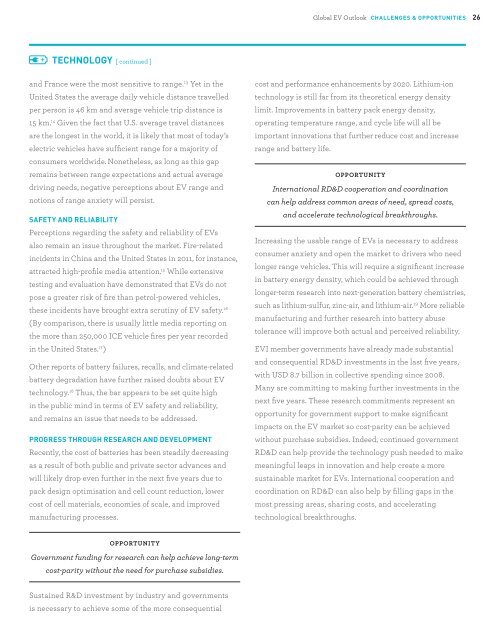Understanding the Electric Vehicle Landscape to 2020 - IEA
Understanding the Electric Vehicle Landscape to 2020 - IEA
Understanding the Electric Vehicle Landscape to 2020 - IEA
Create successful ePaper yourself
Turn your PDF publications into a flip-book with our unique Google optimized e-Paper software.
Global EV Outlook CHALLENGES & OPPORTUNITIES<br />
26<br />
TECHNOLOGY [ continued ]<br />
and France were <strong>the</strong> most sensitive <strong>to</strong> range. 13 Yet in <strong>the</strong><br />
United States <strong>the</strong> average daily vehicle distance travelled<br />
per person is 46 km and average vehicle trip distance is<br />
15 km. 14 Given <strong>the</strong> fact that U.S. average travel distances<br />
are <strong>the</strong> longest in <strong>the</strong> world, it is likely that most of <strong>to</strong>day’s<br />
electric vehicles have sufficient range for a majority of<br />
consumers worldwide. None<strong>the</strong>less, as long as this gap<br />
remains between range expectations and actual average<br />
driving needs, negative perceptions about EV range and<br />
notions of range anxiety will persist.<br />
SAFETY AND RELIABILITY<br />
Perceptions regarding <strong>the</strong> safety and reliability of EVs<br />
also remain an issue throughout <strong>the</strong> market. Fire-related<br />
incidents in China and <strong>the</strong> United States in 2011, for instance,<br />
attracted high-profile media attention. 15 While extensive<br />
testing and evaluation have demonstrated that EVs do not<br />
pose a greater risk of fire than petrol-powered vehicles,<br />
<strong>the</strong>se incidents have brought extra scrutiny of EV safety. 16<br />
(By comparison, <strong>the</strong>re is usually little media reporting on<br />
<strong>the</strong> more than 250,000 ICE vehicle fires per year recorded<br />
in <strong>the</strong> United States. 17 )<br />
O<strong>the</strong>r reports of battery failures, recalls, and climate-related<br />
battery degradation have fur<strong>the</strong>r raised doubts about EV<br />
technology. 18 Thus, <strong>the</strong> bar appears <strong>to</strong> be set quite high<br />
in <strong>the</strong> public mind in terms of EV safety and reliability,<br />
and remains an issue that needs <strong>to</strong> be addressed.<br />
PROGRESS THROUGH RESEARCH AND DEVELOPMENT<br />
Recently, <strong>the</strong> cost of batteries has been steadily decreasing<br />
as a result of both public and private sec<strong>to</strong>r advances and<br />
will likely drop even fur<strong>the</strong>r in <strong>the</strong> next five years due <strong>to</strong><br />
pack design optimisation and cell count reduction, lower<br />
cost of cell materials, economies of scale, and improved<br />
manufacturing processes.<br />
cost and performance enhancements by <strong>2020</strong>. Lithium-ion<br />
technology is still far from its <strong>the</strong>oretical energy density<br />
limit. Improvements in battery pack energy density,<br />
operating temperature range, and cycle life will all be<br />
important innovations that fur<strong>the</strong>r reduce cost and increase<br />
range and battery life.<br />
OPPORTUNITY<br />
International RD&D cooperation and coordination<br />
can help address common areas of need, spread costs,<br />
and accelerate technological breakthroughs.<br />
Increasing <strong>the</strong> usable range of EVs is necessary <strong>to</strong> address<br />
consumer anxiety and open <strong>the</strong> market <strong>to</strong> drivers who need<br />
longer range vehicles. This will require a significant increase<br />
in battery energy density, which could be achieved through<br />
longer-term research in<strong>to</strong> next-generation battery chemistries,<br />
such as lithium-sulfur, zinc-air, and lithium-air. 19 More reliable<br />
manufacturing and fur<strong>the</strong>r research in<strong>to</strong> battery abuse<br />
<strong>to</strong>lerance will improve both actual and perceived reliability.<br />
EVI member governments have already made substantial<br />
and consequential RD&D investments in <strong>the</strong> last five years,<br />
with USD 8.7 billion in collective spending since 2008.<br />
Many are committing <strong>to</strong> making fur<strong>the</strong>r investments in <strong>the</strong><br />
next five years. These research commitments represent an<br />
opportunity for government support <strong>to</strong> make significant<br />
impacts on <strong>the</strong> EV market so cost-parity can be achieved<br />
without purchase subsidies. Indeed, continued government<br />
RD&D can help provide <strong>the</strong> technology push needed <strong>to</strong> make<br />
meaningful leaps in innovation and help create a more<br />
sustainable market for EVs. International cooperation and<br />
coordination on RD&D can also help by filling gaps in <strong>the</strong><br />
most pressing areas, sharing costs, and accelerating<br />
technological breakthroughs.<br />
OPPORTUNITY<br />
Government funding for research can help achieve long-term<br />
cost-parity without <strong>the</strong> need for purchase subsidies.<br />
Sustained R&D investment by industry and governments<br />
is necessary <strong>to</strong> achieve some of <strong>the</strong> more consequential
















